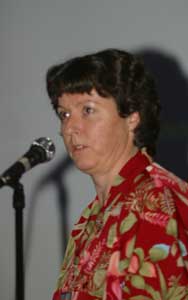Golden Alga (Prymnesium parvum) in Texas
Workshop Abstracts
A Review of Fish-killing Microalgae: Causes, Impacts, and Management with Emphasis on Prymnesium
 Jan
Landsberg
Jan
Landsberg
Florida Marine Research Institute, Florida Fish and Wildlife Conservation Commission, 100 Eighth Avenue Southeast, St. Petersburg, Florida 33712 USA
Abstract.--Harmful algal blooms (HABs) cause mass animal mortalities, shellfish and tropical fish poisonings, respiratory irritation, and neurocognitive disease in humans. Globally, HABs have been directly or indirectly associated with fish kills in a variety of aquatic systems. At least 60 species are ichthyotoxic, and more than 30 species are harmful to fish. The sudden appearance of toxic planktonic blooms, such as red tides that lead to acute, mass fish mortalities, has been historically documented since the mid 1800s. Increased reports of HAB-associated fish kills signify their expanding effects in aquatic systems. Microalgae can affect fish in a number of ways: the production of lethal or sublethal toxins can cause neurological impairment, behavioral change, or neurointoxication; the production of bioactive compounds (e.g., hemolysins) can cause cellular damage, or impair respiration and other physiological functions; toxins can be transferred up the food chain via predation, bioaccumulation, and lethal bioconcentration; microalgal anatomical structures can cause mechanical damage and pathology; microalgae can act as vectors for disease pathogens; they can cause immunosuppression and increase the susceptibility of fish to disease; and they can negatively influence water quality (e.g., low dissolved oxygen, increased ammonia). Historically, many fish kills have been associated with the low dissolved oxygen levels produced by nontoxic algal blooms. At all trophic levels, fish chronically exposed to microalgal toxins can experience lethal or sublethal effects such as impaired feeding, avoidance behavior, physiological dysfunction, impaired immune function, reduced growth and reproduction, pathological effects, and mortality. The wide variety of life strategies adopted by many HAB species suggests that fish in numerous trophic niches can be affected. Traditionally, only planktonic HABs have been recognized as having acute effects, but benthic and predatory HAB species can also kill or harm fish. The majority of fish kills are caused by dinoflagellates such as Karenia, Karlodinium, Gymnodinium, Gyrodinium, and Pfiesteria and others are caused by the raphidophytes Chattonella, Fibrocapsa, and Heterocapsa and the prymnesiophytes Chrysochromulina and Prymnesium. At least four Prymnesium species have been reported to be ichthyotoxic, with the majority of fish kill reports involving P. parvum. Prymnesium produce bioactive glycosides known as prymnesins. Prymnesins are released into the water naturally during Prymnesium blooms with even higher concentrations released during stressful conditions, or after the cells die. Fish are affected directly because prymnesins are absorbed across the gills. Other gill-breathing organisms such as amphibian larvae and shellfish can also be susceptible to prymnesins. Unlike many other toxic microalgae, the toxins from Prymnesium do not affect mammals, so less attention has been drawn to their effects because they are not a public health risk. However, Prymnesium blooms have caused significant ecological and economical impacts. Primarily responsible for high-density blooms and fish kills in aquaculture systems and fish farms, Prymnesium species have also been responsible for significant natural kills in brackish waters. Strategies for management include chemical and biological controls, and predictive monitoring that uses a combination of sensitive bioassays, traditional monitoring methods, and innovative technologies.
Download
presentation  (PDF 2.3 MB). If
you are unable to access this document, please contact
us for an alternative format.
(PDF 2.3 MB). If
you are unable to access this document, please contact
us for an alternative format.